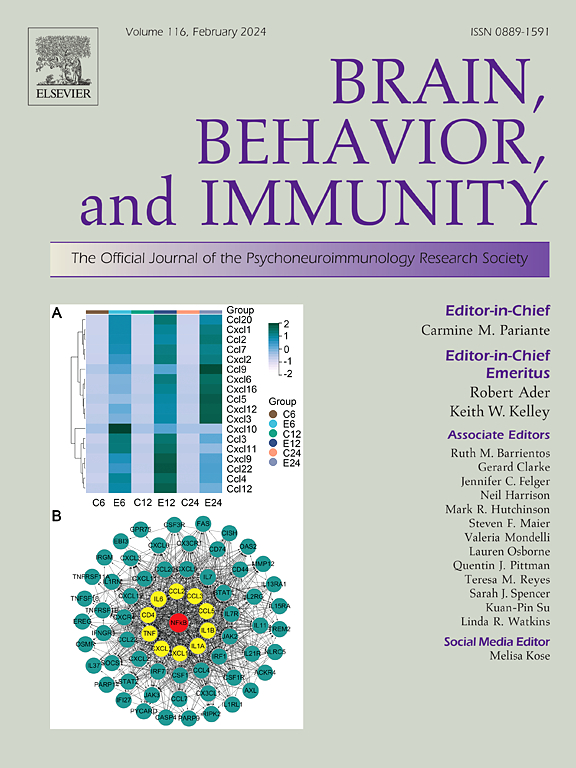揭示吗啡耐受性:CCL2通过抑制Nrf2信号通路和PGC-1α介导的线粒体生物生成诱导脊髓凋亡
IF 8.8
2区 医学
Q1 IMMUNOLOGY
引用次数: 0
摘要
背景:吗啡能有效缓解剧烈疼痛,但长期使用会导致镇痛耐受。吗啡耐受的分子机制尚不完全清楚。现有文献表明,趋化因子CCL2存在于脊髓中,在中枢神经系统炎症,包括神经性疼痛中起作用。然而,CCL2介导吗啡耐受的确切机制尚未阐明。因此,本研究旨在探讨CCL2参与吗啡镇痛耐受发展的分子途径。方法:大鼠鞘内注射吗啡(10 μl /5 μl),每天2次,连续7 d,建立吗啡伤害耐受模型。采用Western blotting和定量实时聚合酶链反应(qRT-PCR)检测CCL2表达水平及其相关机制分子。免疫荧光法检测CCL2在脊髓中的定位。鞘内注射抑制剂或激动剂,人为调节相关分子的表达。采用热甩尾实验评价大鼠吗啡耐受性。结果:吗啡诱导的脊髓CCL2表达显著升高,Nrf2和PGC-1a表达下调。免疫荧光显示CCL2增强的免疫应答主要与神经元共定位。在体内,我们证实鞘内注射CCL2抑制剂Bindarit可有效减轻细胞凋亡的发生,减轻吗啡耐受。同样,Nrf2信号通路激动剂Oltipraz和PGC-1α激动剂ZLN005预处理也分别取得了类似的结果。ROS荧光检测试剂盒显示,增加PGC-1α的表达可通过降低ROS水平来减轻细胞凋亡的发生。结论:我们的数据强调趋化因子CCL2抑制Nrf2信号通路和pgc -1α介导的线粒体生物发生,减轻脊髓细胞凋亡的发生,从而参与吗啡耐受。这可能为吗啡耐受的治疗提供新的靶点。本文章由计算机程序翻译,如有差异,请以英文原文为准。
Unraveling morphine tolerance: CCL2 induces spinal cord apoptosis via inhibition of Nrf2 signaling pathway and PGC-1α-mediated mitochondrial biogenesis
Background
Morphine effectively relieves severe pain but leads to analgesic tolerance with long-term use. The molecular mechanisms underlying morphine tolerance remain incompletely understood. Existing literature suggests that chemokine CCL2, present in the spinal cord, plays a role in central nervous system inflammation, including neuropathic pain. Nevertheless, the precise mechanism through which CCL2 mediates morphine tolerance has yet to be elucidated. Consequently, this study aims to investigate the molecular pathways by which CCL2 contributes to the development of morphine analgesic tolerance.
Methods
Rats were administered intrathecal morphine (10 μg/5 μl) twice a day for seven consecutive days to induce a model of morphine nociceptive tolerance. Western blotting and quantitative real-time polymerase chain reaction (qRT-PCR) were used to detect the expression levels of CCL2 and its related mechanism molecules. Immunofluorescence was used to detect the localization of CCL2 in the spinal cord. Intrathecal injections of inhibitors or agonists to artificially regulate the expression of relevant molecules. The thermal tail-flick experiment was performed to evaluate morphine tolerance in rats.
Results
Morphine-induced CCL2 expression was significantly increased in spinal cord, while conversely, the expressions of Nrf2 and PGC-1a were downregulated. Immunofluorescence showed that the enhanced immune response of CCL2 mainly co-localized with neurons. In vivo, we confirmed that intrathecally injection of CCL2 inhibitor Bindarit could effectively alleviate the occurrence of apoptosis and alleviate morphine tolerance. Similarly, pretreatment with Nrf2 signaling pathway agonist Oltipraz and PGC-1α agonist ZLN005 also achieved similar results, respectively. ROS Fluorescence Assay Kit indicated that increasing the expression of PGC-1α could alleviate the occurrence of apoptosis by reducing the level of ROS.
Conclusion
Our data emphasize that chemokine CCL2 inhibited the Nrf2 signaling pathway and PGC-1α-mediated mitochondrial biogenesis, alleviating the occurrence of apoptosis in spinal cord, thereby participating in morphine tolerance. This may provide new targets for the treatment of morphine tolerance.
求助全文
通过发布文献求助,成功后即可免费获取论文全文。
去求助
来源期刊
CiteScore
29.60
自引率
2.00%
发文量
290
审稿时长
28 days
期刊介绍:
Established in 1987, Brain, Behavior, and Immunity proudly serves as the official journal of the Psychoneuroimmunology Research Society (PNIRS). This pioneering journal is dedicated to publishing peer-reviewed basic, experimental, and clinical studies that explore the intricate interactions among behavioral, neural, endocrine, and immune systems in both humans and animals.
As an international and interdisciplinary platform, Brain, Behavior, and Immunity focuses on original research spanning neuroscience, immunology, integrative physiology, behavioral biology, psychiatry, psychology, and clinical medicine. The journal is inclusive of research conducted at various levels, including molecular, cellular, social, and whole organism perspectives. With a commitment to efficiency, the journal facilitates online submission and review, ensuring timely publication of experimental results. Manuscripts typically undergo peer review and are returned to authors within 30 days of submission. It's worth noting that Brain, Behavior, and Immunity, published eight times a year, does not impose submission fees or page charges, fostering an open and accessible platform for scientific discourse.

 求助内容:
求助内容: 应助结果提醒方式:
应助结果提醒方式:


